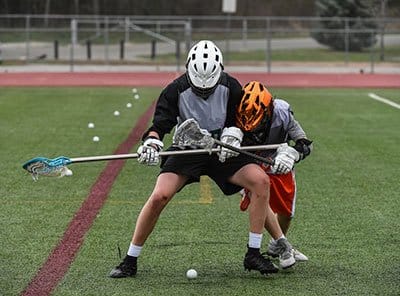If you're a lacrosse enthusiast, you know that playing and watching the sport requires strict adherence to the rules. In recent years, the rules regarding unsportsmanlike conduct penalties have become stricter and more complex.
To help guide readers through this complexity, we've compiled an updated guide on the lacrosse unsportsmanlike conduct penalty for 2023. This article will provide readers with an inside scoop on what constitutes unsportsmanlike behavior in lacrosse and what penalties are associated with these behaviors.
With this information, readers can better understand the consequences of unsportsmanlike conduct in lacrosse and how it can affect their gameplay.
More...
Take away key points:
What is considered as unsportsmanlike conduct in lacrosse?
In lacrosse, unsportsmanlike conduct is any behavior deemed disrespectful or violent to the sport, it's athletes, or its officials.
Unsportsmanlike conduct can also delay the game by not following the rules or trying to gain an unfair advantage.
All of these behaviors are punishable by a range of penalties, such as a warning, suspension, or even expulsion from a game or match. In addition, depending on the severity of the infraction, fines may also be imposed on other players and teams who violate the rules.
The NCAA and US Youth Lacrosse Rules both outline specific unsportsmanlike conduct penalties that can be given out for various infractions. For example, any player who commits an act that is considered unsportsmanlike may be penalized with a personal foul or even ejected from the game.
Additionally, inadvertent touching of the loose ball when the free hand is grasping the lacrosse stick should not be called an unsportsmanlike conduct foul.

7 examples of unsportsmanlike conduct in lacrosse
Unsportsmanlike conduct in lacrosse is any behavior deemed disrespectful or violent to the sport, its athletes, or its officials. 7 examples of such conduct include below:
1. Taunting
Taunting in lacrosse is considered unsportsmanlike conduct and can result in a penalty. Depending on the severity of the taunt, it can be punished with a verbal warning or a minor fine. In more extreme cases, suspensions or expulsion may be handed out.
In addition, teams and players that are found guilty of repeated taunting or other unsportsmanlike behavior may also be subject to higher fines.
2. Intimidating remarks
Intimidating remarks in lacrosse can also lead to penalties. The severity of the penalty depends on the type and intensity of the remark.
Generally, a verbal warning or fine is given for mild comments, while more serious remarks may result in suspensions or expulsions. Teams and players that repeatedly make such remarks may also be subject to higher fines.
3. Verbal abuse
Verbal abuse in lacrosse is taken seriously and can lead to penalties. Depending on the severity of the abuse, it can be punished with a minor fine or a verbal warning.
In more extreme cases, suspensions or expulsion may be handed out. Teams and players guilty of repeated verbal abuse may also be subject to higher fines.
4. Physical violence of any kind
Physical violence of any kind in lacrosse is not tolerated and can lead to severe penalties. Depending on the severity and nature of the incident, punishments may include suspensions or expulsions.
In addition, teams and players who repeatedly commit such offenses may be subject to harsher fines or other disciplinary action.
5. Delaying the game by not following the rules
Delaying the game by not following the rules is a serious offense in lacrosse and can result in penalties. Minor offenses may be punished with verbal warnings, while more serious offenses could lead to suspensions or expulsions.
Teams and players who continue to delay the game may be subject to higher fines or other disciplinary action.
6. Trying to gain an unfair advantage
Trying to gain an unfair advantage through any means is a major offense in lacrosse and can have serious repercussions. Depending on the severity of the incident, punishments may include verbal warnings, suspensions or expulsions, or a technical foul.
Teams and players that repeatedly break the rules in this manner may be subject to even harsher fines or other disciplinary action.
7. Damaging equipment intentionally
Intentionally damaging equipment such as a lacrosse stick is a serious offense in lacrosse and can result in lacrosse penalties. Depending on the severity of the incident, punishments may range from verbal warnings to suspensions or expulsions.
In addition, teams and players who continue to damage equipment may be subject to harsh fines or other disciplinary action and receive a technical foul.
The penalty for unsportsmanlike conduct

If an athlete or team is found guilty of unsportsmanlike conduct, the penalty will depend on the severity of the offense of the offending team.
For minor infractions such as taunting or abusive language, the player may receive a warning from the referee and may be removed from the field for some time. If more serious offenses are committed, such as physical violence or trying to gain an unfair advantage, players can face suspension or even expulsion from a game or match.
If a player is found guilty of repeated unsportsmanlike behavior, they can face expulsion from a match or even the entire season. In some cases, fines may also be imposed on teams and players who violate the rules regarding unsportsmanlike conduct.
When the opposing team or the opposing player has possession of the ball, or the defense gains possession of the ball, normal play is permitted to continue until their ownership of the loose ball dissipates. This delay in enforcement is termed a slow whistle and enables an advantage for the offense. Major violations constitute personal fouls that are strictly penalized.
Penalties can also include fines for both players and teams, depending on the seriousness of the violation. In some cases, legal action may also be taken against those responsible for violating rules regarding unsportsmanlike conduct in lacrosse.
The least intrusive form of penalty is the releasable penalty. A releasable penalty allows an offending player in the penalty box/ penalty area to re-enter play if their opposing team scores before their entire penalty time has expired. Usually, the releasable penalty is given out for minor technical fouls as they don't impede gameplay significantly. Minor penalties typically last for one to three minutes, and the player needs to respect the restricted area until the time expires.
The ramifications of a non-releasable penalty are far graver than a releasable one. With the non-releasable penalty, whatever amount of time is given to the offending player must be completed, even if their opponents score goals in that timeframe.
Unsportsmanlike conduct fouls
If a player commits two unsportsmanlike conduct fouls during the game, they will be immediately ejected and removed from the field area. Furthermore, all unsportsmanlike conduct fouls are accompanied by a 15-yard penalty.
The NCAA (NCAA.org) outlines that any player, substitute, coach, or another person subject to the rules of the game cannot use abusive, threatening, or obscene language or gestures nor engage in any acts that can provoke ill will or demean an opponent, official or the sport itself.
Final words
In conclusion, lacrosse unsportsmanlike conduct penalty is often serious and can even lead to expulsion from the game. Therefore, it is important to ensure that players know the regulations and consequences of their actions on the field.
Common penalties similar to unsportsmanlike conduct include unnecessary roughness, delay of game, illegal screen, flagrant fouls, illegal contact violations, illegal body checks, illegal procedures, and foul language.
